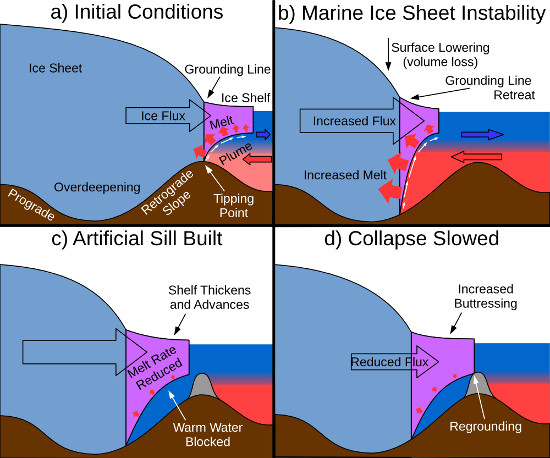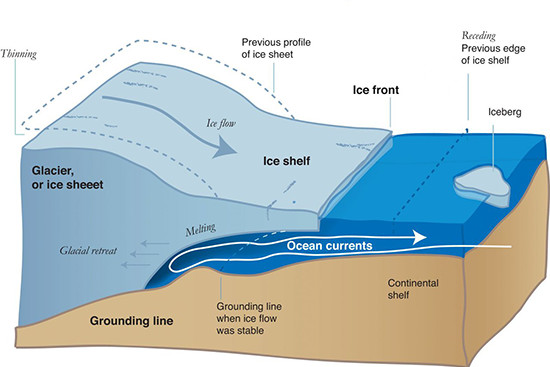Targeted engineering projects to hold off glacier melting could slow down the collapse of ice sheets and limit sea-level rise, according to a new study published in the European Geosciences Union journal The Cryosphere.
While an intervention similar in size to existing large civil
engineering projects could only have a 30% chance of success, a larger
project would have better odds of holding off ice-sheet collapse. But
study authors Michael Wolovick and John Moore caution that reducing emissions still remains key to stopping climate change and its dramatic effects.
“Doing geoengineering means often considering the unthinkable,” says
Moore, a scientist at Beijing Normal University, China, and a professor
of climate change at the University of Lapland, Finland. The term
‘geoengineering’ is usually applied to large-scale interventions to
combat climate change. But instead of trying to change the entire
climate, Wolovick and Moore say we could apply a more targeted approach
to limit one of the most drastic consequences of climate change:
sea-level rise.
Their “unthinkable” idea is glacial geoengineering: making changes to
the geometry of the seafloor near glaciers that flow into the ocean,
forming an ice shelf, to prevent them from melting further. Some
glaciers, such as the Britain- or Florida-sized Thwaites ice stream in
West Antarctica, are retreating fast. “Thwaites could easily trigger a
runaway [West Antarctic] ice sheet collapse that would ultimately raise
global sea level by about 3 metres,” explains Wolovick, a researcher at
Princeton University’s Department of Geosciences, US. This could have
dramatic effects to the millions of people living in the world’s coastal
areas.
Instead of, or in addition to, limiting the effects of rising seas
through traditional coastal protection, using glacier geoengineering to
stop the flood at the source could be a viable option, as Wolovick and
Moore show. “The most important result [of our study] is that a
meaningful ice sheet intervention is broadly within the order of
magnitude of plausible human achievements,” says Wolovick.
The team looked into two glacial-geoengineering designs. One idea would
be to build a wall underwater to block warm water reaching an ice
shelf’s base, which is very sensitive to melting. A simpler design
consists of constructing artificial mounds or columns on the seafloor:
they wouldn’t block warm water but could support and hold back the
glacier, helping it regrow. “In either case, we were imagining very
simple structures, simply piles of sand or gravel on the ocean floor,”
says Wolovick.
The team ran computer models where they applied these designs to
Thwaites Glacier in a warming world. Thwaites is projected to be the
largest individual source of future sea-level rise and, at 80 to 100 km
wide, it’s one of the widest glaciers in the world. “If [glacial
geoengineering] works there then we would expect it to work on less
challenging glaciers as well,” the authors write in The Cryosphere study.

Brown represents bedrock, light blue represents grounded ice sheet,
purple represents floating ice shelf, and gray represents an artificial
sill. Ocean temperatures are drawn to represent the typical
stratification faced by marine-terminating ice streams: warm salty water
at depth and cold fresh water near the surface. Credit: Wolovick &
Moore, The Cryosphere, 2018
The research shows that even the simpler design could slow down the rate
of sea-level rise, giving more time to coastal societies to adapt to
rising waters. The smallest intervention has a 30% probability of
preventing a runaway collapse of the West Antarctic Ice Sheet for the
foreseeable future, according to the models. This intervention would
consist of building isolated 300-metre-high mounds or columns on the
seafloor using between 0.1 and 1.5 cubic kilometres of aggregate,
depending on the strength of the material. This is similar to the amount
of material that was excavated to build the Suez Canal in Egypt (1
cubic kilometre) or used in Dubai’s Palm Islands (0.3 cubic kilometres).
A more sophisticated project, going beyond the scale humanity has
attempted so far, would have higher chances of success in avoiding a
runaway ice-sheet collapse within the next 1000 years (the time the
simulations run for), as well as better odds of causing the ice sheet to
regain mass. A small underwater wall blocking about 50% of warm water
from reaching the ice shelf base could have 70% chance of succeeding,
while larger walls would be even more likely to delay or even stop
ice-sheet collapse.
When the bedrock slopes inward toward the continent, warm, deep
ocean water can flow downward under the ice shelf, chewing away at the
grounding line. Melting can be as much as 20 to 50 metres of ice
thickness each year. As the glacier’s base recedes, the brakes holding
the continental ice ease up and the glaciers feeding the ice shelf
accelerate, and thus further thin and recede the ice sheet. Credit:
Jeremy Harbeck/NASA IceBridge
Despite the encouraging results, the scientists say they don’t advocate
starting these ambitious projects any time soon. While the simplest
design would be similar in scale to existing engineering projects, it
would be built in one of Earth’s harshest environments. So, the
engineering details still need to be worked out. Nonetheless, the team
wanted to see whether glacial geoengineering could work in theory, and
wanted to get the scientific community to think about, and improve on,
the designs.
“We all understand that we have an urgent professional obligation to
determine how much sea level rise society should expect, and how fast
that sea level rise is likely to come. However, we would argue that
there is also an obligation to try to come up with ways that society
could protect itself against a rapid ice-sheet collapse,” says Wolovick.
Ice physics shows glacial geoengineering could work to hold off
ice-sheet collapse, but both Wolovick and Moore are adamant that
reducing greenhouse-gas emissions remains a priority in the fight
against climate change. “There are dishonest elements of society that
will try to use our research to argue against the necessity of
emissions’ reductions. Our research does not in any way support that
interpretation,” they say.
Engineering glaciers would only limit sea-level rise, while reducing
emissions could also limit other harmful consequences of climate change,
such as ocean acidification, floods, droughts and heat waves. In
addition, the team points out that more warming would mean glacial
engineering projects would become less feasible and would have lower
chances of success. After all, their underwater structures might protect
the bottom of the ice shelves, but wouldn’t prevent warm air from
eating away the ice at the top.
“The more carbon we emit, the less likely it becomes that the ice sheets
will survive in the long term at anything close to their present
volume,” Wolovick concludes.
More information:
Wolovick, M. J. and Moore, J. C.: Stopping the flood: could we use targeted geoengineering to mitigate sea level rise?, The Cryosphere, 12, 2955–2967, 2018.
For further information, welcome to listen the open lecture of John C. Moore “Stopping the flood – Can we engineer ice sheets and save the homes of a billion people?” on 24 October at 4 PM. The lecture takes place in Arktikum house in Rovaniemi, Finland (Pohjoisranta 4).
Research Professor John C. Moore
Arctic Centre, University of Lapland
+356 40 019 4850, john.moore.bnu(at)gmail.com
Photo credit: Credit: NASA/Jim Yungel
Press release: The European Geosciences Union (EGU)